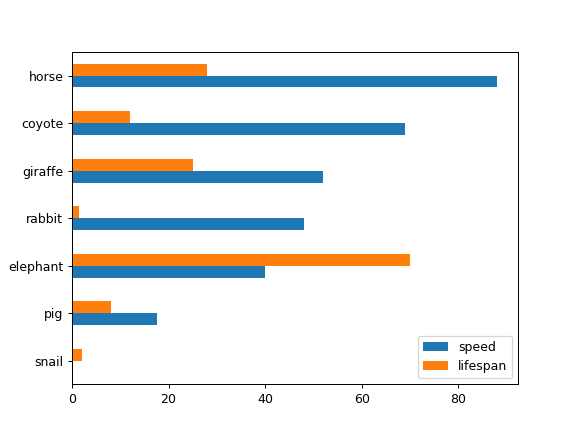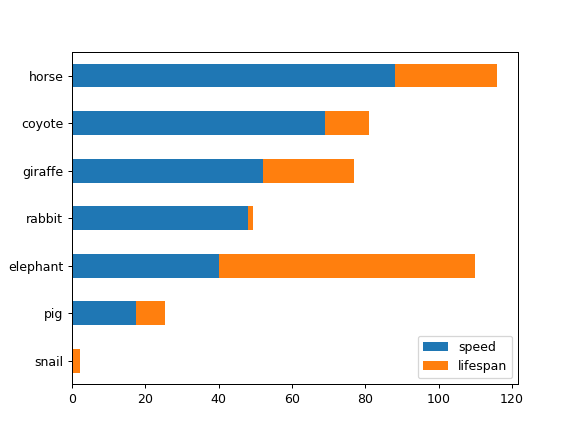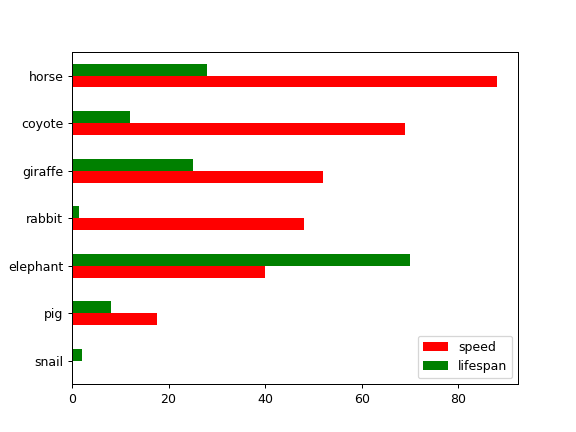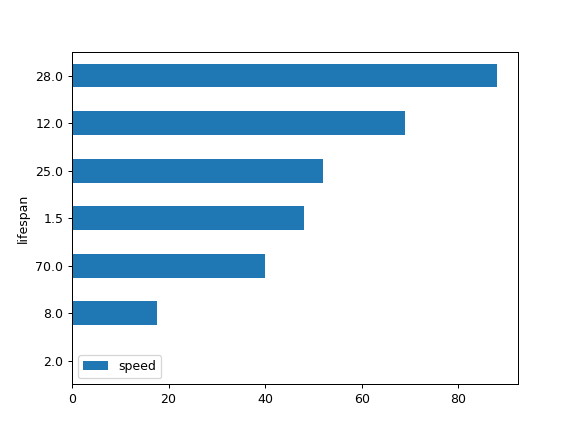pandas.DataFrame.plot.barh¶
- DataFrame.plot.barh(x=None, y=None, **kwargs)[source]¶
Make a horizontal bar plot.
A horizontal bar plot is a plot that presents quantitative data with rectangular bars with lengths proportional to the values that they represent. A bar plot shows comparisons among discrete categories. One axis of the plot shows the specific categories being compared, and the other axis represents a measured value.
- Parameters
- xlabel or position, optional
Allows plotting of one column versus another. If not specified, the index of the DataFrame is used.
- ylabel or position, optional
Allows plotting of one column versus another. If not specified, all numerical columns are used.
- colorstr, array_like, or dict, optional
The color for each of the DataFrame’s columns. Possible values are:
- A single color string referred to by name, RGB or RGBA code,
for instance ‘red’ or ‘#a98d19’.
- A sequence of color strings referred to by name, RGB or RGBA
code, which will be used for each column recursively. For instance [‘green’,’yellow’] each column’s bar will be filled in green or yellow, alternatively.
- A dict of the form {column namecolor}, so that each column will be
colored accordingly. For example, if your columns are called a and b, then passing {‘a’: ‘green’, ‘b’: ‘red’} will color bars for column a in green and bars for column b in red.
New in version 1.1.0.
- **kwargs
Additional keyword arguments are documented in
DataFrame.plot().
- Returns
- matplotlib.axes.Axes or np.ndarray of them
An ndarray is returned with one
matplotlib.axes.Axesper column whensubplots=True.
See also
DataFrame.plot.barVertical bar plot.
DataFrame.plotMake plots of DataFrame using matplotlib.
matplotlib.axes.Axes.barPlot a vertical bar plot using matplotlib.
Examples
Basic example
>>> df = pd.DataFrame({'lab': ['A', 'B', 'C'], 'val': [10, 30, 20]}) >>> ax = df.plot.barh(x='lab', y='val')

Plot a whole DataFrame to a horizontal bar plot
>>> speed = [0.1, 17.5, 40, 48, 52, 69, 88] >>> lifespan = [2, 8, 70, 1.5, 25, 12, 28] >>> index = ['snail', 'pig', 'elephant', ... 'rabbit', 'giraffe', 'coyote', 'horse'] >>> df = pd.DataFrame({'speed': speed, ... 'lifespan': lifespan}, index=index) >>> ax = df.plot.barh()

Plot stacked barh charts for the DataFrame
>>> ax = df.plot.barh(stacked=True)

We can specify colors for each column
>>> ax = df.plot.barh(color={"speed": "red", "lifespan": "green"})

Plot a column of the DataFrame to a horizontal bar plot
>>> speed = [0.1, 17.5, 40, 48, 52, 69, 88] >>> lifespan = [2, 8, 70, 1.5, 25, 12, 28] >>> index = ['snail', 'pig', 'elephant', ... 'rabbit', 'giraffe', 'coyote', 'horse'] >>> df = pd.DataFrame({'speed': speed, ... 'lifespan': lifespan}, index=index) >>> ax = df.plot.barh(y='speed')

Plot DataFrame versus the desired column
>>> speed = [0.1, 17.5, 40, 48, 52, 69, 88] >>> lifespan = [2, 8, 70, 1.5, 25, 12, 28] >>> index = ['snail', 'pig', 'elephant', ... 'rabbit', 'giraffe', 'coyote', 'horse'] >>> df = pd.DataFrame({'speed': speed, ... 'lifespan': lifespan}, index=index) >>> ax = df.plot.barh(x='lifespan')
